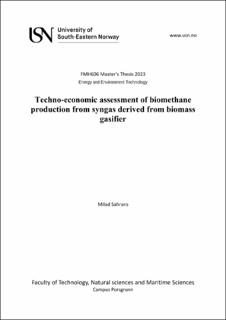| dc.description.abstract | Biomethane is one of the renewable fuels widely utilized for various purposes, including transportation, heating, and power production. Growing interest is currently seen in this biofuel production utilizing waste material such as agricultural residual, sludge and municipal solid waste in anaerobic digestion. However, there is a limitation in using entire organic biomass in anaerobic digestion due to lignocellulose mass and fibrous material, which is hard to digest by microbes. Thus, gasification could be a supplementary technology to utilize residual, digested, and contaminated waste. The coupling of gasification and anaerobic digestion has been tested in lab scale reactor to valorize the waste as biofuel. However, techno-economic evaluation is essential to upscale the technology. Thus, this master's thesis aimed to perform the techno-economic of coupling gasifier and anaerobic digestion to utilize syngas for biomethane production. Three potential scenarios were evaluated for their techno-economic viability. Scenario 1 is based on biomethane generation through syngas fermentation coupled with gasification. Combination of hydrothermal gasification, syngas fermentation, and a steam addition as a hydrogen source make up Scenario 2. In scenario 3, an electrolytic unit was added instead of steam (in scenario 2) as a hydrogen source to produce biomethane. The scenarios' efficiencies range from 13% to 35%. The maximum energy efficiency, 35%, was found in Scenario 3. Furthermore, scenario 1 (237 NOK per litre) was followed by scenario 2 (164 NOK per litre) and scenario 3 (120 NOK per litre) as the scenarios in which the minimum selling price of biomethane decreased. Due to its undiscounted net present value of 76 million NOK compared to the other scenarios, scenario 3 is the most profitable based on the discounted cash flow analysis results. According to sensitivity analysis, the cost of labour and utility had the most impact on the minimum selling price of biomethane. | |
